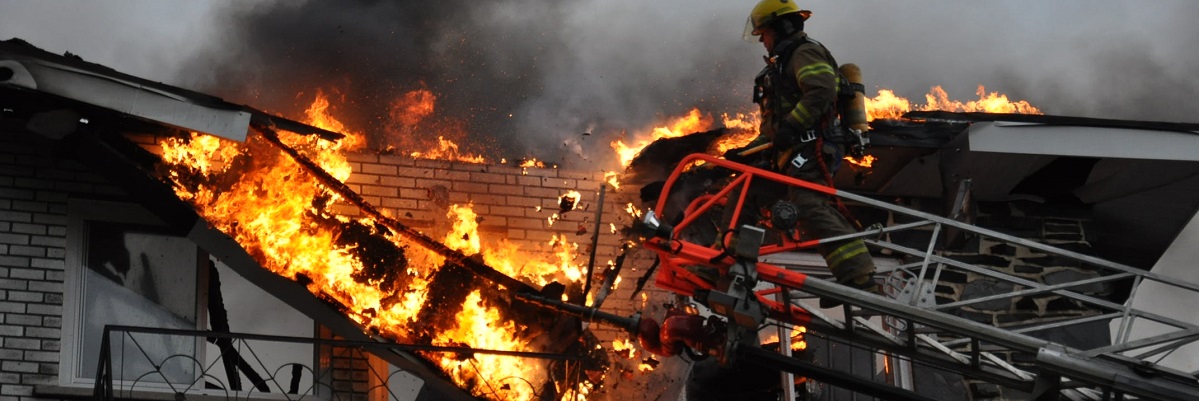Home Fires

One of the most common emergencies experienced by Canadians is a fire in their home. In Canada, house fires are most likely to occur between December and March.
The most common causes of house fires are cooking (leaving the stove unattended), improperly extinguishing cigarettes and candles left unattended. The best way to protect yourself and your family from a home fire is to follow these steps:
- Check your smoke and Carbon Monoxide alarms every month.
- Know and practice your evacuation plan.
- Get out and STAY OUT - never return to a burning building.
Before
- The key to staying safe is to prepare and to have an emergency plan in place.
- Install smoke alarms and carbon monoxide detectors on every level of your home. Test the alarms every month and replace the batteries twice a year, at daylight savings time (March and November).
- If you are a tenant, test your evacuation plan with your landlord and neighbours.
- If you live in a highrise, know how to evacuate the building. Use stairs instead of the elevator.
- Make sure everyone knows where the fire extinguishers are kept.
- Prevent Fires:
- Clean chimneys annually.
- Keep flammable items at least one metre from heat sources, such as space heaters, fireplaces and the stove.
- Never smoke in bed.
- Never leave candles unattended.
- Stay in the kitchen when using the stove top. If you have to leave the room, turn off the stove.
- Talk to children about the dangers of fire and keep lighters and matches out of reach.
- Most home fires happen during the holiday period and the winter months. Christmas trees can get very dry when inside and can catch fire very easily. Make sure you water the tree regularly and use approved lights.
- Learn fire safety techniques and teach them to your family regularly. Make sure everyone is familiar with the technique “STOP, DROP, AND ROLL” in case clothing catches on fire.
- Show children the alarms and practice what to do if the alarms sound.
- Talk with your family and neighbours about what you would do during a house fire.
- Have practice drills with your family, so you know what to do and are prepared.
- Make a personalized preparedness emergency kit. Families should be prepared to be self-sustaining for at least three days.
- If you have already dipped into your emergency kit and food supply while staying at home, consider safely getting the supplies to replenish it following your local public health authorities’ guidelines for leaving your residence.
During
- Get out and stay out. Follow your escape plan. Do not stop.
- If closed doors or handles are warm, use an alternate exit.
- Crawl under low smoke.
- If smoke, heat or flames block your exit, stay in the room with the doors closed. Place a wet towel under the door and call 9-1-1. Open a window and wave a brightly coloured cloth or use a flashlight to signal for help.
- Once you are outside, go to your designated meeting place and then send one person to call the fire department. If you cannot get to your meeting place, follow your family emergency communication plan.
After
- Only re-enter your home if you are authorized by officials to do so.
- Check on vulnerable family members, friends and neighbours who may require special assistance.
- Have injuries treated by a medical professional.
- Contact your local government office for help in finding temporary housing if you cannot stay in your home due to fire damage.
- Contact your insurance company, if necessary.
- Take precautions while cleaning your property. Wear protective gear including boots, safety glasses and rubber gloves when cleaning up.
- Household items often take several cleanings to be rid of smoke odours, soot and stains. Take an inventory of ruined furniture, appliances, books, etc. for insurance purposes and keep all receipts related to living expenses, repairs, etc.
- Ensure your food and water is safe. Discard any food that may have been exposed to heat, smoke or soot and do not use water that may be contaminated.
- For more information on what to do after a fire, please download our Guide to Fire Recovery.
Learn More : Home Fires: Information & Facts
After a Disaster
Recovering after a disaster can be overwhelming. Check out what resources the Red Cross has to offer.
Get an Emergency Kit
Getting or making a kit is the final step in being ready for any emergency. Find out what you need to put in it.
